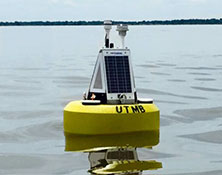The University of Toledo Water Quality Buoy Project
The UT Buoy Project is intended to provide water managers and the public with advance warning of harmful algal blooms (HABs) developing in Maumee Bay.
The buoy is equipped with sensors that continuously monitor and report the following water quality parameters:
- Chlorophyll concentration, a measure of total algae
- Phycocyanin concentration, a measure of blue-green (HAB) algae
- Water temperature and dissolved oxygen concentration
- pH, an indicator of algal growth rates
- Conductivity, an indicator of Maumee River vs. Detroit River influence
- Turbidity, an indicator of sediment re-suspension and algae
- Wind speed and direction
Research Goals
- Development of multi-institutional HAB warning network to provide lake-wide coverage
- Improve current methods of remote water quality monitoring and data interpretation
- Improve understanding of how HABs develop in western Lake Erie
- Train students in lake ecology and water quality methodology
Funds for this project were provided by the Ohio Department of Higher Education.



